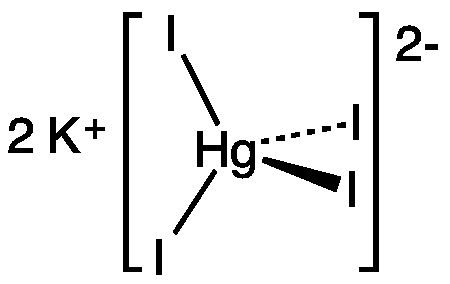Formula HgI4K2 Appearance yellow crystals | Density 1.16 g/cm³ | |
 | ||
Potassium tetraiodomercurate ii
Potassium tetraiodomercurate(II) is an inorganic compound consisting of potassium cations and the tetraiodomercurate(II) anion. It is mainly used as Nessler's reagent, a 0.09 mol/L solution of potassium tetraiodomercurate(II) (K2[HgI4]) in 2.5 mol/L potassium hydroxide, used to detect ammonia.
Contents
Preparation and structure
Crystallizing from a concentrated aqueous solution of mercuric iodide with potassium iodide is the monohydrate KHgI3.H2O, which is pale orange. In aqueous solution this triodido complex adds iodide to give the tetrahedral tetraiodo dianion.
Solutions of K2HgI4 react with Cu(I) salts to give Cu2HgI4.
Nessler's reagent
Named after Julius Nessler, an alkaline solution of K2HgI4 is called Nessler's reagent. This pale solution becomes deeper yellow in the presence of ammonia. At higher concentrations, a brown precipitate may form. The sensitivity as a spot test is about 0.3 μg NH3 in 2 μL.
NH4+ + 2[HgI4]2− + 4OH− → HgO·Hg(NH2)I ↓ + 7I− + 3H2OThe formula for the brown precipitate is given as 3HgO.Hg(NH3)2I2 and as NH2.Hg2I3
Nessler's reagent is generally prepared by combining potassium iodide and mercury(II) chloride. Nessler's reagent may be used with Nessler tubes.
